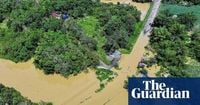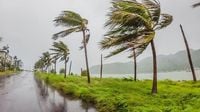Tropical Storm Fengshen, locally known as "Ramil," has battered the Philippines, leaving a trail of destruction, heartbreak, and uncertainty in its wake. Over the course of several days leading up to October 20, 2025, the storm unleashed torrential rains, fierce winds, and widespread flooding across northern and central regions of the archipelago, disrupting the lives of more than 130,000 people and triggering a massive emergency response.
According to the National Disaster Risk Reduction and Management Council, the storm—which made landfall on October 18 on southern Catanduanes Island before sweeping northwest across Luzon—resulted in at least seven confirmed deaths and left two individuals missing. The official tally documented the storm's impact across nine provinces and thirty-five cities and municipalities, a stark reminder of the extensive reach and power of this weather system.
Yet, some reports put the death toll even higher. As The Guardian noted, eight people have died, with five fatalities occurring in a single tragic incident near Pitogo when a large tree, weakened by the storm, crashed onto a house early Sunday morning. Among the victims were two children, underscoring the vulnerability of families caught in the path of nature’s fury. In another incident, a resident drowned in Roxas City, Capiz province, after high tides compounded the flooding on October 18.
The storm’s ferocity forced the evacuation of tens of thousands. The government’s disaster-mitigation agency reported that approximately 37,825 families—or 133,196 individuals—were affected, with nearly 14,000 people still displaced as of Monday morning. Of those, 7,511 sought refuge in 166 government-run evacuation centers, while another 6,199 found shelter with relatives or in safer locations away from the immediate danger. In Albay province alone, 27,000 people were evacuated in anticipation of severe coastal flooding, following warnings from the Philippine weather bureau, Pagasa, that waves could reach two meters (about six feet).
For many, the storm’s timing could not have been worse. Fengshen struck as the central and southern provinces were still reeling from a series of strong earthquakes that had killed more than 80 people and damaged over 134,000 houses in Cebu province alone. The Philippines, positioned between the Pacific Ocean and the South China Sea, is frequently battered by about 20 typhoons and storms each year and is also prone to earthquakes and volcanic eruptions. This relentless barrage of natural disasters makes the country one of the most disaster-prone on the planet—a fact that shapes daily life and government policy in equal measure.
Transportation and logistics across the region have been significantly disrupted. As reported by SeaNews, landslides and water damage have compromised inland transport routes, and port operations are expected to face delays due to the lingering effects of the storm. With roads washed out and bridges damaged, the movement of goods and aid has become a logistical challenge, further complicating recovery efforts for affected communities.
Fengshen’s winds, which reached sustained speeds of 65 km/h with gusts up to 80 km/h as it exited the Philippines, are expected to strengthen as the storm crosses the South China Sea. The Joint Typhoon Warning Centre forecasted that the system could reach sustained winds of 70 mph as it turns southwest, heading toward Vietnam, with landfall anticipated on October 24. This has prompted Vietnamese authorities to prepare for possible evacuations and warnings, especially as the country has already faced Typhoons Kajiki and Bualoi earlier in the 2025 season.
In the Philippines, the aftermath of Fengshen is marked not only by the immediate loss of life and property but also by the longer-term challenges of recovery. The storm’s impact was felt most acutely in vulnerable, low-lying, and landslip-prone villages, where families often have scant resources to rebuild. The government’s disaster-mitigation agency described the situation as dire, noting that "nearly 14,000 people who evacuated remained displaced from their homes by Monday." For many, the path to recovery will be long and uncertain.
Despite the devastation, the country’s disaster preparedness systems were put to the test. The rapid establishment of evacuation centers and the timely issuance of weather warnings by Pagasa likely saved lives, even as the storm’s unpredictable nature led to tragic outcomes. The government’s efforts were complemented by local officials and community volunteers, who worked tirelessly to move residents to safety and provide essential supplies.
Fengshen’s impact also coincided with the start of the northeast monsoon season across Southeast Asia, which typically brings heavy rainfall and flooding risks to parts of India, including Kerala and Tamil Nadu. The India Meteorological Department has warned of further heavy rainfall and potential flooding as the monsoon intensifies, with up to 150mm of rain possible along the east coast this week. There is even the potential for a tropical depression to form over the Bay of Bengal, signaling that the broader region remains on high alert for further weather-related disruptions.
For Filipinos, the storm is a sobering reminder of the country’s perpetual vulnerability—and resilience. The Philippines’ experience with Fengshen illustrates both the relentless challenge of living in a disaster-prone region and the strength of communities that, time and again, are forced to pick up the pieces. As one provincial police chief, Romulo Albacea, explained after the tragic deaths in Pitogo, "Five people, including two children, died while they were sleeping when their hut was hit on Sunday by a huge palm tree that they had burned before to try to topple it for safety reasons." Such stories bring home the very human cost of these recurring disasters.
With the storm now moving west and forecasts indicating further strengthening, attention is shifting to Vietnam and neighboring countries. Emergency responders and disaster officials across the region are bracing for impact, hoping that lessons learned from previous storms will help mitigate the damage. But for the thousands of Filipinos displaced by Fengshen, the focus remains on rebuilding homes, restoring livelihoods, and supporting families who have lost everything.
In the end, Tropical Storm Fengshen has left a mark not only on the physical landscape of the Philippines but also on the collective psyche of its people. The storm’s passage is a stark illustration of nature’s power—and the enduring spirit of those who must endure it, rebuild, and prepare for whatever comes next.





